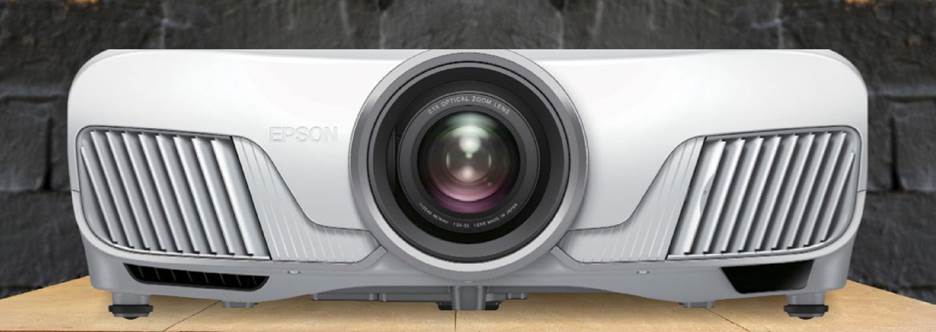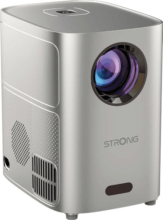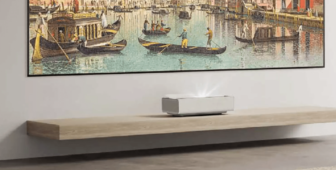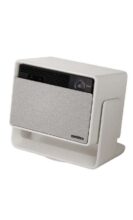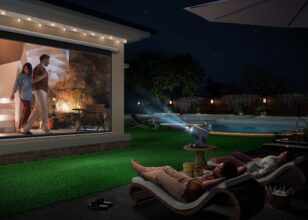EPSON EH-TW9400W Review
Epson’s new generation of projectors uses a powerful combo of brightness and colour to deliver images that rivals true UHD.
Since its previous series of home theatre projectors some three years ago, Epson has re-branded its UHD technology to Epson ‘4K PRO-UHD’. This uses 1080p panels with pixel shifting to increase resolution above 1080p. (Epson does, in fact, make full 4K projectors for professional use. But they have massive light sources.)
So the emphasis here is much more on a wide colour gamut and improved support for the High Dynamic Range that comes with most Ultra-HD content. There is much to be said for this approach, and as we’ll see, it proves itself in the image quality. Epson notes that terms like HDR weren’t developed with projectors in mind. Nonetheless, Epson’s aim has been to push towards the bright end of the range envisaged by HDR standards. That’s up to 10,000 nits. The projector can’t get there, but Epson has tried to make the projector as bright as possible. It rates the output of the Epson EH-TW9400W at 2600 lumens, both in white and in colour, the latter being something which projection methods which share their brightness among the three primary colours can’t achieve.
As for colour, this one is rated to cover 100% of the DCI-P3 colour space, the standard for digital cinema. Of note, an ‘Ultra-HD Premium’ certification requires covering only 90% of DCI-P3.
NO LONG HDMI CABLES
The ‘W’ at the end of the model number means that it is fitted with WirelessHD connectivity. A separate box with four HDMI inputs is provided.
This accepts connections from your source devices (it has an optical and HDMI output for passing audio on to a receiver as well) and it passes the video wirelessly to the projector. It’s easy to see what an enormous boon this can be in many likely layouts, especially given the issues in running long HDMI cables. This ‘W’ wirelessness adds only $ over the price of the otherwise-identical non-wireless TW9400. You could save that just from the price of those cables, let alone the benefits of neatness.
The projector uses three Epson LCD panels.
The glass allows a very generous zoom range of 2.1-to-1 and it has a large range of lens shift, both horizontally and vertically. Those features make it easy to install, as does the fact that all these adjustments are powered, so you can stand right next to the screen as you’re making them, rather than teetering on a chair, stretching to reach the control rings on a projector lens. The powered adjustments also allow it to have lens position memories, useful if your circumstances mean using two different screens, or an anamorphic set-up.
For a 100-inch (2.54-metre) 16:9 screen, the projector needs to be at a distance of between 3 and 6.3 metres from the screen.
The remote features backlit keys, and plenty of them, so that it’s easy to change settings on the projector. It had plenty of power to bounce its IR signal off our screen and back to the sensor on the front of the projector.
The projector supports 3D, though you’ll need to buy additional bits and pieces for that.
PERFORMANCE
If you feed the Epson an Ultra-HD test pattern which has single-pixels lines vertically and horizontally, it’s clear from the on-screen result that it doesn’t define things as well as a device with true Ultra-HD resolution, though it did seem to yield a little more detail than full HD.
But this is not real-world material; you’re unlikely to find a single pixel line in a 4K movie via UHD Blu-ray or Foxtel or Netflix, while the vast majority of content for most viewers will be upscaled from Blu-ray or broadcast.
So let’s put aside test patterns. With real content the colour was gorgeous, and the projector was wonderfully bright. Particularly impressive was the bold, almost hyper-real colours of Billy Lynns Long Halftime Walk. We were watching wirelessly, and this is a rare 60 frames-per-second movie (see below) so we switched to the wired HDMI connection to get the full 12 bits and 4:2:2 colour, and it looked even bolder and brighter. Home theatre projection has never looked this good at anywhere near this price. The wonderful reds of the Deadpool movies were conveyed beautifully. The grain of some older movies transferred to Ultra-HD, such as the 1984 Ghostbusters, was softened to the point of near-removal. That was about the only clear evidence from real material that the Ultra-HD resolution isn’t fully realised.
We went back to test patterns to see how brightness levels were handled. Using the test patterns on a Sony Ultra-HD Blu-ray disc (hit the number keys 7669 on your remote while on the main menu), chapters 19 to 22 show grey-scale patterns from 0 to 10,000 nits. There is no way any existing projector can deliver this range, even 1000 nits. So the projector make has to make judgements. What lower boundary of input will it make its minimum black? What upper for its maximum white? Too close to the extremes and near-blacks and near-whites will lack intensity. Too far and they’ll crush. These test patterns showed a discernible difference between 0.005 and 0.010 nits for black, and 1200 and 1300 nits for white. That’s a good choice. Those responsible for mastering Ultra-HD Blu-ray discs are unlikely to push anywhere near the 10,000 nits point as yet.
Black levels were up to Epson’s high standards. Even without the dynamic iris in operation, the darker scenes were subjectively impressive. And in a sense, black level weaknesses in a projector are less objectionable anyway than they are in a TV, because they are even across the screen with the projector. With many LCD TVs, in darker scenes the images tends to look mottled, and that’s far more distracting.
So, you may be wondering how well the WirelessHD carries the Ultra-HD signal. Very well indeed is the answer. With a regular Ultra-HD Blu-ray disc, the projector’s information screen showed it was getting 3840 by 2160 pixels with 12-bit, 4:2:2 colour in BT.2020 format, along with HDR. That’s almost the same as with a cable connection, but in that case the Ultra-HD Blu-ray player chose 4:4:4 colour.
However with 60 frames per second Ultra-HD, as on that Billy Lynn disc, the wireless transmitter is limited to 8-bit, 4:2:0 colour. The projector said that the format was still BT.2020 and HDR10, but we can’t see how HDR10 can work with 8-bit colour. With wired, it went to 12 bits and 4:2:2. Thankfully, 60fps Ultra-HD Blu-ray remains extremely rare. And in any case, pictures are stored at 4:2:0 on Ultra-HD Blu-ray (or regular Blu-ray or DVD or digital TV, and streaming can crush them even lower). Ultimately it must be converted to 4:4:4 for display, but whether than happens in the player or the display device doesn’t really matter, so long as the conversion is competently performed.
A previous Epson model, the EH-TW9300W, exhibited rather weird handling of 1080i/50 and 576i/50 content, but there’s none of that here. Frames are respected, as they should be. But there could still be a little extra work on the deinterlacing of 1080i/50 and 576i/50 content. It has selectable deinterlacing: Off, Video and Film/Auto. The last is the default, and it has a bash at detecting film-sourced content, despite it being delivered in interlaced format… but it wasn’t quite up with the best of them in performance. With one torture test 576i/50 clip we use from the movie Gigi, for example, the horizontally-striped vest of Manuel kept the projector flickering from film to video mode, resulting in moire patterns across the vest. Given that the camera was usually moving, that also necessarily reduces resolution in the rest of the image.
With Miss Potter, delivered from 1080i/50 Blu-ray, most of it seemed about average, with a slight break-up in one of the tricky scenes. But once the credits began to roll at the end of the movie, it was clear that these were being treated as video-sourced rather than film-sourced, resulting in wiggling and break-up of the small horizontal strokes in the text. This is a little disappointing, since some older Epson projectors had a force-film mode, which ensured perfect delivery of film- sourced content.
The projector includes frame interpolation, or motion-smoothing, as Epson premium models have for many years. This doesn’t work with Ultra-HD content, nor with lower-resolution material that’s upscaled to Ultra-HD output. With regular 1080p/24 content, not upscaled, it did a decent job of smoothing motion, but at the cost of producing artifacts. With the Blu-ray of the 1993 movie The Fugitive, the flyover of Chicago at 50 minutes in
Epson is aiming to deliver the best possible result under $, and has achieved wonders here…
is smoothed very nicely. But a moment later, when Harrison Ford is on the phone to his lawyer, a train goes past behind him on a bridge. The rivets on the bridge waver and squirm in an unseemly manner when motion smoothing is running.
So it’s probably no loss not to have it disabled for Ultra-HD content.
CONCLUSION
While we look forward to the day when Epson releases a true Ultra-HD resolution home projector at a price like this, we’d be fibbing if we said that the difference of true 4K would significantly improve what you get in the Epson EH-TW9400W, with the exception that the higher resolution would more transparently reproduce the Ghostbusters grain. But that’s a purist view, especially as that movie looks better without it! With this projector Epson is aiming to deliver the best possible result under $, and has achieved wonders here, with the brightness and colour in particular, and the significant bonus of the transmitter box which does away with the need for the worries of long and expensive HDMI cables.
Epson EH-TW9400W wireless AV projector
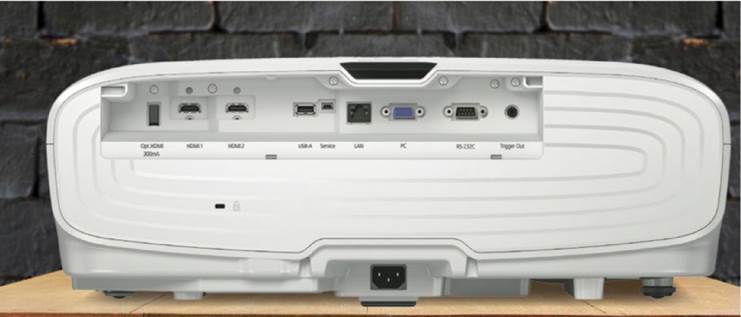
Wired or wireless: The Epson has two HDMI inputs, but also comes with a transmitter box which can send even 4K signals wirelessly to the projector, saving the hassle of long HDMI cables.
Beautiful colour and brightness Excellent installation flexibility WirelessHD connection Hints at full UHD resolution
Could improve 50Hz deinterlacing, or have a force-film mode option
Projection technology: 3 x 18.8mm Polysilicon TFT active matrix LCD panels Resolution: 1920 by 1080 pixels Aspect ratio: 16:9 Lamp: 250 watts UHE-E Lamp life: 3500 hours, 5000 economy mode Contrast ratio: 1,200,000:1 (Dynamic) Brightness: 2600 lumens (white and colour) Inputs: WirelessHD (4 x HDMI on transmitter, 1 with MHL support), 2 x HDMI, 1 x D-SUB15,
1 x Ethernet
Outputs (on transmitter): 1 x HDMI,
1 x optical digital audio, USB charging port Control/Other: 1 x RS-232C, 1 x trigger,
1 x Mini-USB (Service), 1 x USB (for WiFi option), 1 x USB power (for active optical HDMI cable)
Dimensions (whd): 520 x 193 x 450mm Weight: 11.2kg
Contact: Epson Australia Telephone: 1300 361 054 Web: www.epson.com.au

